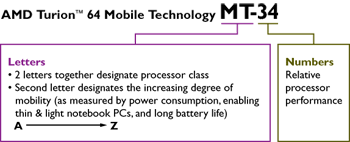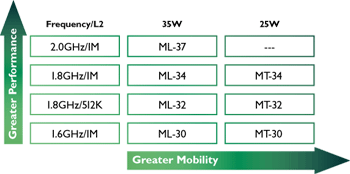Pentium, Schmentium: Decoding CPU Names
The Power Class Influx
Once a month, Intel sends a product roadmap update to its business partners in order to discuss future products, product names, availability and pricing. The October version included initial information about the naming and numbering of Intel's next generation mobile processor, code-named Yonah.
According to the most recent roadmap, it has not yet been determined whether all of the new CPUs - available both as single or dual core - will still be called Pentium M. What we do know is that the upcoming numbering system will have four rather than three digits. That alone does not sound too bad, because we are already used to needing to look up numbers, and one more digit will not make much of a difference with that.
But Intel's marketing whizzes apparently believe, for some reason, that it is beneficial to introduce a letter code that indicates the thermal design power (TDP) class of the processor as well. This letter is followed by a performance and feature rating that is not related to any physical characteristic of the chip - such as its clock speed - and does not even serve as a comparison tool throughout the whole Yonah product family.
Here is what Intel is currently planning for dual core Yonah processors:
- U represents processors with a TDP of no greater than 14 W (Ultra low voltage)
- L represents processors with a TDP between 15 and 24 W (Low voltage)
- T represents processors with a TDP between 25 and 49 W
- E represents processors with a TDP greater than or equal to 50 W
Initially, Intel will be shipping Yonah dual cores T1300-T1700, models L1300 to L1500 as well as U1500.
Earlier, we mentioned that Intel's model numbers allow the comparison of performance and features - a current Pentium M 780 therefore is likely to be faster than a current 755 model. The letter code for Yonah chips adds another twist: 1500 in the U series does not equal 1500 in the T series. The clock speed for the Yonah T1500, L1500 and U1500 are 2.0, 1.83 and 1.06 GHz, respectively - all for the sake of meeting their designated thermal power. In addition, the system clock speed is FSB667 with the E, T and L models, but FSB533 with the U variants. Got it?
Well, and then there is the Yonah single core processor, which will be released as ultra-low voltage versions, which would be U, only. However, Intel decided not to use the power class characterization here, so it's Yonah single core 1100 and 1200 for the time being. Also, it's not yet clear whether the server version of Yonah, called Sossaman, is going to carry the power class identifier at all. But there are enough letters left in the alphabet to introduce even more differentiators that no one will be able to keep track of.
Get Tom's Hardware's best news and in-depth reviews, straight to your inbox.
AMD Was First, Again
When we discuss processor power classification confusion, we need to point the finger at AMD as well. In the end, it was the Turion 64 that introduced the new nomenclature that dumped the traditional processor classification based only on clock speed or general performance.
Turion 64 chips are described by two characters and a double-digit number; an example would be the Turion 64 ML-34. According to AMD, the first letter "M" simply indicates that it is a mobile processor. The second character is more interesting, as it is a marker for the chip's power class. The more you move towards the end of the alphabet, the less power the Turion 64 is going to consume. Today, there are L and T versions available - with the "T" models consuming less power than "L" variants.
The number is rather simple to explain, as it represents the chip's performance - the higher the number, the faster the chip. Still, if you imagine yourself in a situation where you are comparing two notebooks at Best Buy - one with a Pentium M 755 chip, the other one with a Turion 64 MT-32 - would you know what features these chips offer and how fast they are? And then, would you be able to figure out how they compare to everything else available in their market segment? Will the salesperson know?
We confronted AMD with our concerns about possible customer confusion during the introduction of the Turion 64. Company officials conceded that it is virtually impossible to determine all of the individual features of a certain processor by its sequence number. According to a spokesperson, only AMD's sales people are able to immediately tell what's behind a model number - sometimes. In other words, AMD is absolutely aware that customers are confused - and we would expect Intel to be equally aware of this fact - but the motivation to introduce less transparency is simply to change buying habits of users. Yesterday, users bought devices by selecting processor speeds; tomorrow, AMD believes, consumers will simply select a product category and just accept whatever processor comes with it.

Patrick Schmid was the editor-in-chief for Tom's Hardware from 2005 to 2006. He wrote numerous articles on a wide range of hardware topics, including storage, CPUs, and system builds.

